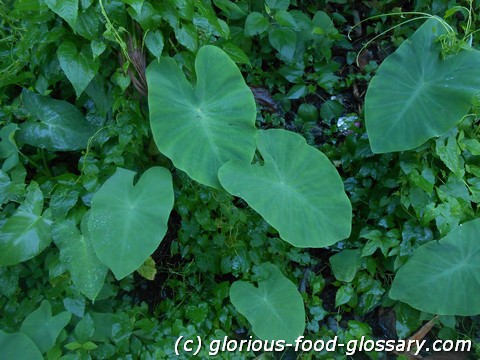Deutsch: Taro-Blätter / Español: Hojas de Taro / Português: Folhas de Taro / Français: Feuilles de Taro / Italiano: Foglie di Taro
Dahon ng Gabi in the food context refers to the leaves of the taro plant (Colocasia esculenta), commonly used in various cuisines around the world, particularly in Filipino cooking. Taro leaves are large, heart-shaped, and green, known for their ability to be cooked into a variety of dishes. They are often used in stews, curries, and as wrappers for steamed or baked dishes. Rich in vitamins and minerals, taro leaves must be cooked before consumption to eliminate oxalates, substances that can cause irritation and discomfort if ingested raw.
Description
Dahon ng Gabi is celebrated in Filipino cuisine for its versatility and nutritional benefits. One of the most famous dishes using taro leaves is Laing, a spicy and creamy dish made by simmering the leaves in coconut milk, chili, shrimp paste, and sometimes with pieces of meat or fish. When cooked, taro leaves become tender and absorb the flavors of the dish, offering a unique texture and taste that complements the rich, creamy sauce. Their use is not limited to Filipino cuisine; taro leaves are also utilized in African, Caribbean, and South Asian cuisines, among others.
Application Areas
Dahon ng Gabi is used in various culinary applications, such as:
- Stews and Curries: Cooked slowly to absorb flavors and achieve a tender texture.
- Wrappers: Used to wrap fish, meat, or rice before cooking, adding flavor and moisture to the dish.
- Side Dishes: Prepared as a nutritious side dish, often cooked with coconut milk or other flavorful sauces.
Well-Known Examples
In addition to Laing, taro leaves are featured in several notable dishes across different cultures, including:
- Callaloo: A popular dish in Caribbean cuisine where taro leaves are often substituted for amaranth leaves, cooked with coconut milk, spices, and sometimes seafood or meat.
- Palusami: A dish from the Pacific islands, especially Samoa, where taro leaves are wrapped around coconut cream and onion, then baked or steamed.
Recipes
A basic recipe for preparing Dahon ng Gabi (as in Laing) includes:
-
Ingredients:
- Taro leaves, dried or fresh, thoroughly cleaned
- Coconut milk
- Chili peppers, according to taste
- Shrimp paste or fish sauce for seasoning
- Optional: meat or seafood for added protein
-
Preparation:
- If using fresh taro leaves, ensure they are cooked thoroughly to eliminate oxalates.
- Simmer coconut milk with chili peppers, shrimp paste, and optional meat or seafood until flavors meld.
- Add the taro leaves, cover, and cook until the leaves are tender and the sauce is thickened.
- Serve hot with rice.
Treatment and Risks
It's important to handle and cook Dahon ng Gabi properly to avoid the risk of oxalate poisoning, which can cause throat irritation and more severe health issues if consumed in large amounts. Cooking the leaves thoroughly neutralizes these compounds.
Similar Terms or Synonyms
- Taro Leaves
- Laing (when referring to the dish made from taro leaves)
Summary
Dahon ng Gabi refers to taro leaves, a versatile and nutritious ingredient in many cuisines, particularly in the Philippines. These leaves can be used in a variety of dishes, from creamy stews to flavorful wraps. Rich in nutrients and offering a unique texture and taste, taro leaves are a culinary staple in regions where they are readily available. Proper preparation and cooking are essential to ensure their safety and enjoy their full flavor.
--


